
Cimexomys is an extinct North American mammal that lived from the Upper Cretaceous to the Paleocene. For a while, it shared the world with dinosaurs, but outlived them. It was a member of the extinct order Multituberculata and lies within the suborder Cimolodonta. It is perhaps a member of the Paracimexomys group, though it is not certain.
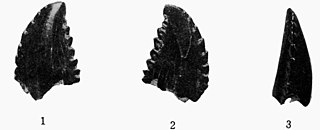
Troodon is a former wastebasket taxon and a potentially dubious genus of relatively small, bird-like theropod dinosaurs definitively known from the Campanian age of the Late Cretaceous period. It includes at least one species, Troodon formosus, known from Montana. Discovered in October 1855, T. formosus was among the first dinosaurs found in North America, although it was thought to be a lizard until 1877. Several well-known troodontid specimens from the Dinosaur Park Formation in Alberta were once believed to be members of this genus. However, recent analyses in 2017 have found this genus to be undiagnostic and referred some of these specimens to the genus Stenonychosaurus some to the genus Latenivenatrix, and some to the genus Pectinodon. The genus name is Ancient Greek for "wounding tooth", referring to the teeth, which were different from those of most other theropods known at the time of their discovery. The teeth bear prominent, apically oriented serrations. These "wounding" serrations, however, are morphometrically more similar to those of herbivorous reptiles, and suggest a possibly omnivorous diet.

Archaeornithomimus is a genus of ornithomimosaurian theropod dinosaur that lived in Asia during the Late Cretaceous period, around 96 million years ago in the Iren Dabasu Formation.

Bagaceratops is a genus of small protoceratopsid dinosaurs that lived in Asia during the Late Cretaceous, around 72 to 71 million years ago. Bagaceratops remains have been reported from the Barun Goyot Formation and Bayan Mandahu Formation. One specimen may argue the possible presence of Bagaceratops in the Djadochta Formation.
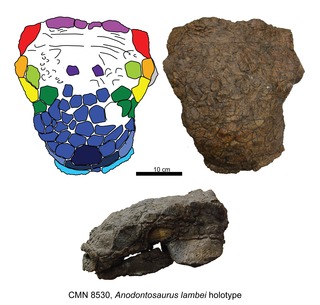
Anodontosaurus is an extinct genus of ankylosaurid dinosaurs within the subfamily Ankylosaurinae. It is known from the entire span of the Late Cretaceous Horseshoe Canyon Formation of southern Alberta, Canada. It contains two species, A. lambei and A. inceptus.

Sphaerotholus is a genus of pachycephalosaurid dinosaur from the Upper Cretaceous of the western United States and Canada. To date, five species have been described: the type species, S. goodwini, from the Den-na-zin Member of the Kirtland Formation of San Juan County, New Mexico, USA; S. buchholtzae, from the Hell Creek Formation of western Carter County, Montana, USA and the Frenchman Formation of Saskatchewan, Canada; S. edmontonensis, from the Horseshoe Canyon Formation of Alberta, Canada; S. lyonsi, from the Dinosaur Park Formation (Campanian) of Alberta, Canada; and S. triregnum from the Hell Creek Formation of Garfield County, Montana, USA.

Prenoceratops, is a genus of herbivorous ceratopsian dinosaur from the Late Cretaceous Period. It was a relatively small dinosaur, reaching 1.3 m (4.3 ft) in length and 20 kg (44 lb) in body mass. Its fossils have been found in the upper Two Medicine Formation in the present-day U.S. state of Montana, in Campanian age rock layers that have been dated to 74.3 million years ago. Fossils were also found in the Oldman Formation in the modern day Canadian province of Alberta, dating to around 77 million years ago.
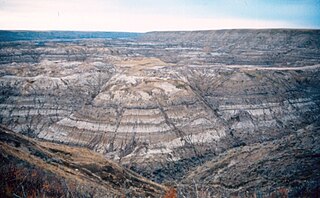
The Horseshoe Canyon Formation is a stratigraphic unit of the Western Canada Sedimentary Basin in southwestern Alberta. It takes its name from Horseshoe Canyon, an area of badlands near Drumheller.

The Bearpaw Formation, also called the Bearpaw Shale, is a geologic formation of Late Cretaceous (Campanian) age. It outcrops in the U.S. state of Montana, as well as the Canadian provinces of Alberta and Saskatchewan, and was named for the Bear Paw Mountains in Montana. It includes a wide range of marine fossils, as well as the remains of a few dinosaurs. It is known for its fossil ammonites, some of which are mined in Alberta to produce the organic gemstone ammolite.
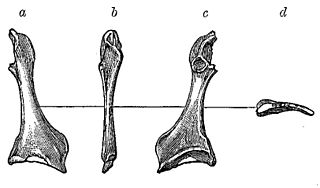
Cimolopteryx is a prehistoric bird genus from the Late Cretaceous Period. It is currently thought to contain only a single species, Cimolopteryx rara. The only specimen confidently attributed to C. rara was found in the Lance Formation of Wyoming, dating to the end of the Maastrichtian age, which ended about 66 million years ago. The dubious species "Cimolopteryx" maxima has been described from both the Lance Formation and the Hell Creek Formation of Montana. The humeral end of a left coracoid from the Frenchman Formation of southern Saskatchewan has also been attributed to the genus.
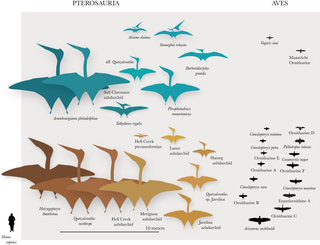
Palintropus is a prehistoric bird genus from the Late Cretaceous. A single species has been named based on a proximal coracoid from the Lance Formation of Wyoming, dated to the latest Maastrichtian, 66 million years ago. Coracoids and a proximal scapula of two unnamed species from the upper Campanian Dinosaur Park Formation of Alberta, dating to between 76.5 and 75 million years ago, are also known.
Paleontology or palaeontology is the study of prehistoric life forms on Earth through the examination of plant and animal fossils. This includes the study of body fossils, tracks (ichnites), burrows, cast-off parts, fossilised feces (coprolites), palynomorphs and chemical residues. Because humans have encountered fossils for millennia, paleontology has a long history both before and after becoming formalized as a science. This article records significant discoveries and events related to paleontology that occurred or were published in the year 2002.
Paleontology or palaeontology is the study of prehistoric life forms on Earth through the examination of plant and animal fossils. This includes the study of body fossils, tracks (ichnites), burrows, cast-off parts, fossilised feces (coprolites), palynomorphs and chemical residues. Because humans have encountered fossils for millennia, paleontology has a long history both before and after becoming formalized as a science. This article records significant discoveries and events related to paleontology that occurred or were published in the year 2004.
Paleontology or palaeontology is the study of prehistoric life forms on Earth through the examination of plant and animal fossils. This includes the study of body fossils, tracks (ichnites), burrows, cast-off parts, fossilised feces (coprolites), palynomorphs and chemical residues. Because humans have encountered fossils for millennia, paleontology has a long history both before and after becoming formalized as a science. This article records significant discoveries and events related to paleontology that occurred or were published in the year 2005.
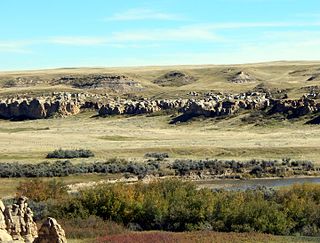
The Foremost Formation is a stratigraphic unit of Late Cretaceous (Campanian) age that underlies much of southern Alberta, Canada. It was named for outcrops in Chin Coulee near the town of Foremost and is known primarily for its dinosaur remains and other fossils.
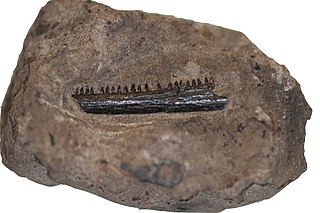
Cteniogenys is a genus of choristodere, a morphologically diverse group of aquatic reptiles. It is part of the monotypic family Cteniogenidae. The type and only named species, C. antiquus, was named in 1928 by Charles W. Gilmore. The holotype, VP.001088, was collected in the Morrison Formation, Wyoming in 1881 by William H. Reed. More specimens have been discovered since then, including specimens from the Late Jurassic of Portugal and Middle Jurassic of Britain, which have not been assigned to species.
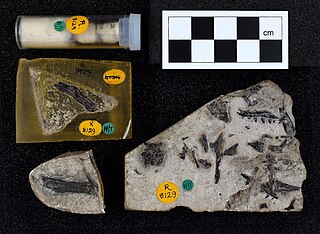
Dorsetisaurus is a genus of extinct lizard, known from the Late Jurassic of North America, and the Late Jurassic-earliest Cretaceous of Europe. The genus was first reported from the Early Cretaceous (Berriasian) Lulworth Formation of the Purbeck Group of Durlston Bay, in Dorset. It has also been reported from the Late Jurassic aged Alcobaça Formation of Portugal and Morrison Formation of Western North America present in stratigraphic zones 2, 4, and 5. It is considered the oldest widely accepted member of Anguimorpha. based on the presence of 11 shared synapomorphies.
Unescoceratops is a genus of leptoceratopsid ceratopsian dinosaurs known from the Late Cretaceous of Alberta, southern Canada. It contains a single species, Unescoceratops koppelhusae.

Gryphoceratops is an extinct genus of leptoceratopsid ceratopsian dinosaur known from the Late Cretaceous of Alberta, southern Canada.

Citipes is an extinct genus of caenagnathid dinosaurs known from the Late Cretaceous Dinosaur Park of southern Alberta, Canada. It lived about 76.9–75.8 million years ago. The specializations of the beak in Citipes and other caenagnathids suggest that they were herbivores. The type species, C. elegans had been previously placed within the genera Chirostenotes, Elmisaurus, Leptorhynchos and Ornithomimus.















